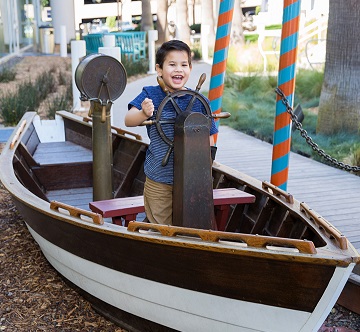By Josh Baxt
Kupono Kahapea is a miracle child. In 2014, he contracted a virus that found its way to his heart, causing a condition called myocarditis. Within months, the once-healthy 6-year-old was on the verge of death.

Courtesy of Healthy Kids magazine: Kupono’s mother and medical support team were thrilled to see Kupono grab the ship’s wheel and stand up—the first time he’d done it on his own.
He was flown from Oahu to Rady Children’s Hospital-San Diego and immediately placed on the transplant list. While waiting for his transplant, Kupono was attached to a ventricular assist device (VAD), an external artificial heart. Kupono’s medical odyssey included more than a month on the VAD, a stroke, a heart transplant, and an ulcerated colon. He came close to death on multiple occasions but survived and is now doing well.
Rady Children’s heart team’s surgical expertise and cutting-edge technology saved Kupono, but that was only part of the story. While Kupono’s parents, Kalei and Lani, were impressed by the machinery that helped keep their son alive, it was the human contact that really touched them. They name a long list of supporters: the staff at the Ronald McDonald House, the child life specialists who helped Kupono adjust under difficult circumstances, the nurses and case workers—and on and on. In the world of pediatric cardiac care, it takes a village.
A Transplant Program Close to Home
Transplant families must often endure incredible displacement to save their child. The Kahapeas have been in San Diego for more than a year—leaving jobs, family, and home. Until Rady Children’s implemented its pediatric heart transplant program, the same had been true for San Diegans. “Before the program, patients and their families had to relocate to Los Angeles or another city with a pediatric transplant center for a year or longer,” says John Lamberti, M.D., director of the Heart Institute, chief of pediatric cardiovascular surgery, and clinical professor of surgery at UC San Diego. “We had to have a transplant program in San Diego.” After years of planning, the program opened in 2015 and has conducted six transplants—all successful. But the transplant is only one piece of a larger picture. There’s waiting for a heart, the persistent need to address pre- and post-surgical complications, and wrestling with each patient’s immune system to avoid rejection.
Kupono also benefited from Rady Children’s two-decade relationship with Kapiolani Medical Center in Honolulu, which enables Dr. Lamberti and other clinicians to share their cardiovascular expertise to help children in Hawaii and on other Pacific Rim islands. After being transported by air ambulance to Rady Children’s, Kupono had to wait only 40 days for his new heart, but he was in bad shape. “He arrived critically ill,” says Rakesh Singh, M.D, M.S., medical director of the Pediatric Heart Failure and Transplantation Program and assistant clinical professor of pediatrics at UC San Diego. “Without the VAD, he likely would not have survived the time it would take for a transplant.”
For Kupono’s parents and caregivers, the VAD presented a unique challenge. At 6, Kupono was old enough to recognize his situation but not big enough to fully understand the complexities. Working with child life specialists, nurses, and others, the family hid the garden-hose-size VAD tubes from Kupono, revealing them only gradually. Still, the machine had an immediate positive impact. “When he first got here, his extremities were ice cold. It was like pulling a soda can out of the machine, that’s how cold his legs and feet were,” says Kupono’s father, Kalei. “They put him on the VAD, and we could visibly see him getting better.”
While the machine kept Kupono alive, it also added new risks. Patients hooked up to VADs can develop blood clots, and Kupono suffered a massive stroke. “When we got that phone call, it was like, ‘Wow, what else?’” says his mother, Lani. Kupono could no longer speak or swallow and had muscle weakness on both sides of his body. While he was still hooked up to the VAD, physical, speech, and occupational therapists, neurologists, and other caregivers began helping him with a rehabilitation medicine program. Four weeks later the transplant team gave Kupono his new heart. “We had no idea how many moving parts it takes to do a transplant,” says Kalei. “But the team at the Hospital, they were amazing. They kept us informed the whole way. Like family.”
The Recovery
The Kahapeas have been living at the Ronald McDonald House, adjacent to the Hospital campus, for more than a year, but are cautiously optimistic they will soon go home. There have been setbacks—Kupono’s ulcerated colon caused severe bleeding—but they are hopeful. And while Kupono’s stroke might have killed an older person, children have amazing regenerative abilities. Kupono’s speech therapist had given him some simple homework: Practice saying “moo.”
Meanwhile, his brain was rewiring for greater achievements. “One night I was talking to him and he turned to me and said, ‘I don’t think so, Mom.’ He just started talking again.” Kupono has continued to get better, improving his speech and gaining strength in his limbs. Still, he will have to take ant-irejection medications every day for the rest of his life and receive periodic biopsies to make sure his immune system isn’t attacking the new heart. “Transplantation is not a cure,” says Dr. Singh. “It’s exchanging one disease we cannot control for another we can control.” But that’s okay. For the Kahapea family, it’s about appreciating the little things. “Kupono finally got to go to the beach after 10 months,” says Lani. “He loves playing in the sand and was throwing it everywhere, just 100 percent happy.”
Excerpted from the 2016 Summer issue of Healthy Kids; click here to read the full story.